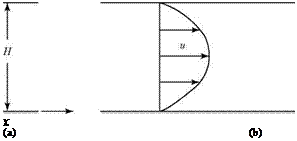Exact Solutions of the Navier-Stokes Equations
If sufficient simplifying assumptions are available in framing a viscous-flow problem, it is possible to find an exact solution to the resulting Navier-Stokes equations. Three examples are presented in this section. In all of these examples, the Navier-Stokes equations become linear and analytical solutions are then possible. Other examples of steady and unsteady problems that permit an exact solution of the Navier-Stokes equations include the impulsively started flat plate, the stagnation-point flow, and the flow between two concentric, rotating cylinders. Detailed treatment of these problems is in White, 1986 and Schlichting, 2003. In the first two examples that follow, two-dimensional airfoil coordinates (x, z) are used rather than the usual two-dimensional coordinates (x, y) to keep our focus on the airfoil/wing viscous-flow problem.
Steady, Parallel, Incompressible Flow Through a Straight Channel
It is assumed that there is a two-dimensional steady flow through an infinitely long channel of unit width and of height H, as shown in Fig. 8.6a. It is assumed further that all flow streamlines are parallel to the solid wall (i. e., w = 0 everywhere). This limits the Re number of the problem to a small enough value so that the flow is laminar. Such a flow is sometimes called Poiseuille flow (Schlichting, 2003).
Figure 8.6. Poiseuille flow.
Because w = 0, the continuity equation, Eq. 8.19, requires that:
d – = 0 ^ u = f(z) only. (8.20)
dx
It follows that the Navier-Stokes Eq. 8.18 reduces to:
0 + 0 = -& + pdu (8.21a)
, dx dz2
0 + 0 = – І + 0. (8.21b)
Notice how the assumption of parallel flow eliminated the nonlinear convective acceleration terms on the left side of the equation. The resulting linear equations are solved easily. The z-momentum equation, Eq. 8.21b, indicates that p depends on the axial position, p = p(x) only. Eq. 8.21a then states:
![]()
 |
dp = d2u dx ^ dz2 ’
function of | = | function of x only ) ^ z only
If the left side of the equation, which is independent of z, is equal to the right side, which is independent of x, then both sides must be independent of both x and z; namely, they both must be equal to a constant. Thus, Eq. 8.21a may be written:
d2u dp
p 2 = = constant, or
dz2 dx (8.22)
dp d2u
= constant; p = constant.
dx dz2
Notice that the pressure gradient in the streamwise direction must be constant. This is the pressure (supplied by a pump or compressor, for example) that pushes the flow in the channel from left to right. The expression, d2u/dz2 = constant, may be integrated twice. This process leads to two constants of integration that are evaluated by applying the no-slip boundary condition at both of the solid walls; namely:
ulz = 0 = 0 = ulz = H
The result of the integration and the application of the boundary condition is:
u=£ f(z2-(823)
where H is the height of the channel. The student should verify this result. This is the equation for a parabolic profile, as plotted in Fig. 8.6b.













